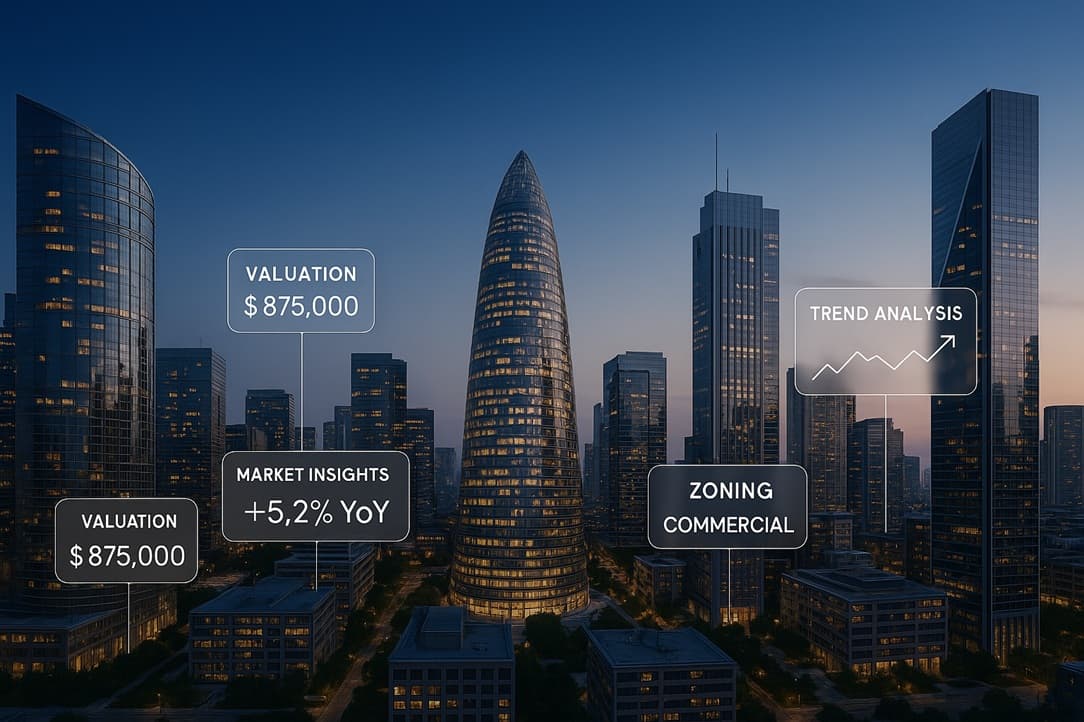Ask GRAI Anything
Your Real Estate Questions, Answered Instantly via Chat


Help us make GRAI even better by sharing your feature requests.

The real estate industry is in the middle of a seismic shift. For decades, the investor’s edge came from information asymmetry: knowing about a neighborhood before others did, securing better financing, or simply running sharper spreadsheets. But in 2025 and especially in the coming years, those advantages are eroding.
Why? Because artificial intelligence (AI) has changed the game.
Most people still think of AI in real estate as a “valuation tool.” That’s outdated. The real edge today is in scenario modeling, risk stress-testing, and global insights - capabilities that go far beyond what Excel or traditional market reports can offer.
This article breaks down how AI in real estate is redefining ROI, what the new investor playbook looks like, and how a real estate AI advisor like GRAI is becoming indispensable for serious investors.
For years, real estate underwriting has revolved around static assumptions:
Mortgage rates stay stable.
Rental demand grows at a fixed percentage.
Insurance costs rise slowly.
Cap rates remain predictable.
But the last five years shattered those assumptions:
Rates doubled between 2021-2023 before moderating in 2025.
Immigration surges reshaped rental markets in Canada, the UK, and the US.
Climate shocks - from floods in India and South Korea to heat waves in Dubai - destroyed housing stock and spiked insurance costs.
Global capital flows pushed prices in cities like Singapore, Lisbon, and Miami far beyond what local incomes could justify.
Related: Global Capital Flows: How Foreign Buyers Shape Real Estate 2025
In this environment, static spreadsheets can’t keep up. Investors need dynamic tools that account for uncertainty - and that’s where AI comes in.
AI isn’t just about predicting today’s property value. It’s about answering questions like:
“What happens to this asset if rates drop another 50 bps?”
“How does ROI shift if immigration inflows to Toronto fall 30%?”
“What’s the impact on cash flow if insurance costs rise 25% after a flood in Mumbai?”
“How does foreign capital inflow change Lisbon’s rental yields by 2027?”
By processing vast data sets - interest rate projections, migration flows, climate risk maps, insurance trends, and capital market shifts - AI can show not just what a property is worth today, but how it performs tomorrow under multiple futures.
That’s a fundamental shift from valuation → foresight.
Must Known: Future of AI in Real Estate: Smart Valuation & Investment Tools
One of the biggest blind spots for traditional investors is treating real estate as a purely local play. In 2025, it isn’t:
US multifamily demand is tied to immigration and remote work trends.
Dubai villas move with Russian, Indian, and Western expat inflows.
Singapore condos are shaped by global family offices parking capital.
Lisbon rentals rise or fall depending on foreign buyer visas and EU policy.
AI lets investors map these international property insights in ways humans can’t - connecting global money flows to local ROI.
AI also flips risk management on its head. Instead of reacting to shocks, investors can stress-test portfolios upfront:
Climate change → “What if half of my coastal assets face 20% insurance premium hikes?”
Political shifts → “How would rental yields change if visa programs shut down?”
Financing shocks → “Can my cash flow survive if rates hold at 6% for 3 more years?”
Traditional underwriting answers none of these. AI not only raises the questions, it quantifies the outcomes - helping investors avoid being blindsided.
Here’s how leading investors are using AI today:
1. Portfolio Optimization
Test allocations across geographies and asset classes. Example prompt: “Model 50% US multifamily, 25% Dubai residential, 25% Singapore luxury through 2030.”
2. Deal Screening
Rapidly identify which markets or properties align with your goals. Prompt: “Filter Southeast Asian cities with yields >8% and low climate risk.”
3. Exit Planning
Model timing of sales against tax changes, rate cycles, and migration flows. Prompt: “Compare exit ROI if I sell in 2026 vs 2028 with immigration caps in place.”
4. Capital Flow Tracking
Anticipate where foreign buyers or institutional investors are pushing demand. Prompt: “Forecast Lisbon rents if Middle Eastern inflows rise 15% by 2027.”
5. Risk Stress-Testing
Build resilience before shocks hit. Prompt: “Simulate cash flow under 25% insurance cost hike post-climate event.”
Generic AI tools can summarize reports. But real estate investors need domain-specific insights. GRAI is built as a global real estate AI advisor with:
Access to global property market data.
Built-in scenario modeling for immigration, climate, rates, and capital flows.
Customizable ROI simulations across geographies and asset types.
Investor-focused outputs - actionable numbers, not vague narratives.
With GRAI, you don’t just ask “What’s this property worth?” You ask:
That’s the edge.
Try it here: https://internationalreal.estate/chat
The Bottom Line
2025 is the year AI stops being a buzzword in real estate and starts being the dividing line between investors who survive - and those who thrive.
Real estate valuations are table stakes.
Scenario modeling is the alpha.
Global insights are the edge.
The investors who embrace AI as a strategic advisor, not just a calculator, will be the ones capturing the best deals, hedging risks before they materialize, and compounding wealth in a world where local and global forces collide daily.